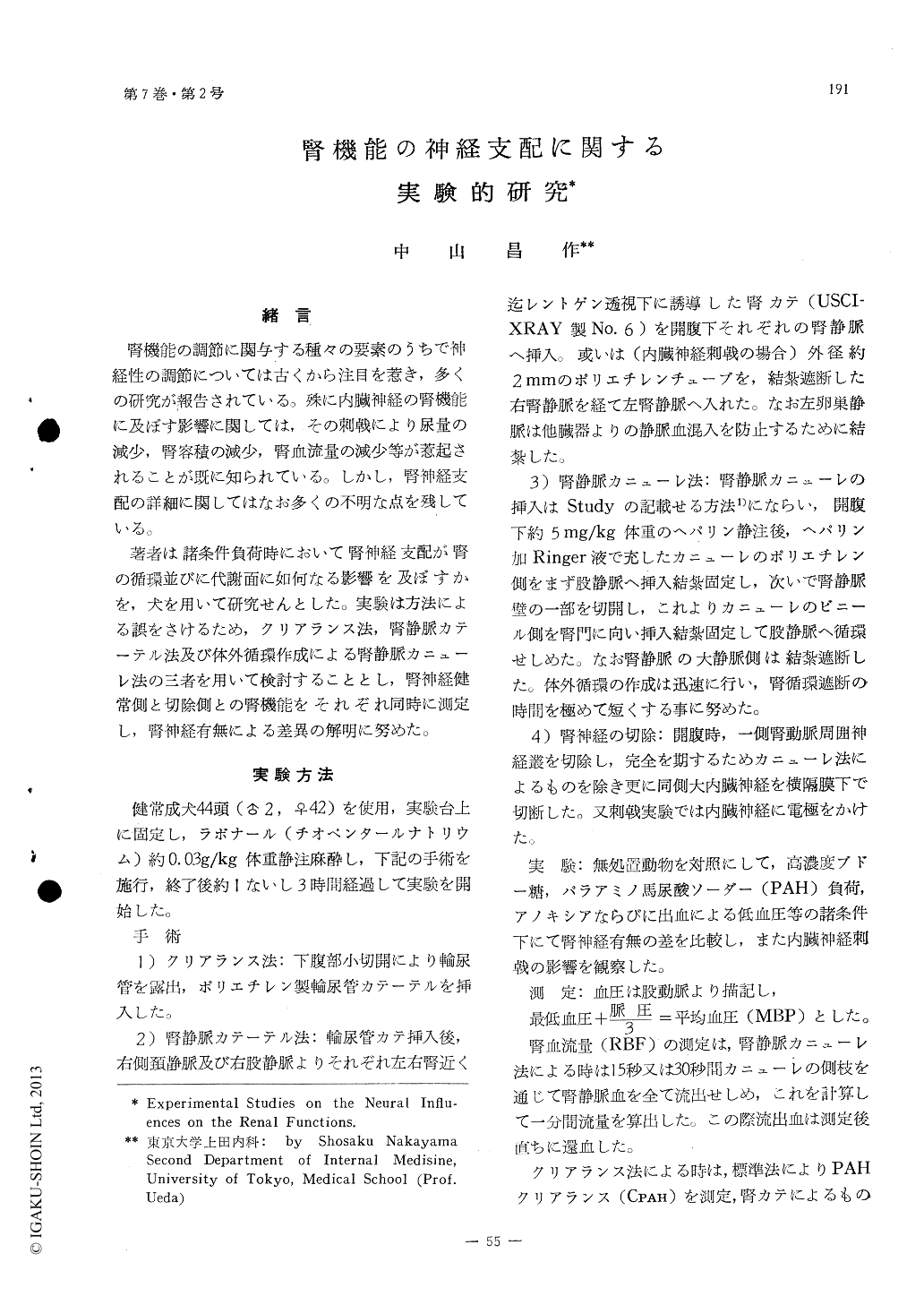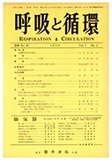Japanese
English
- 有料閲覧
- Abstract 文献概要
- 1ページ目 Look Inside
緒言
腎機能の調節に関与する種々の要素のうちで神経性の調節については古くから注目を惹き,多くの研究が報告されている。殊に内臓神経の腎機能に及ぼす影響に関しては,その刺戟により尿量の減少,腎容積の減少,腎血流量の減少等が惹起されることが既に知られている。しかし,腎神経支配の詳細に関してはなお多くの不明な点を残している。
著者は諸条件負荷時において腎神経支配が腎の循環並びに代謝面に如何なる影響を及ぼすかを,犬を用いて研究せんとした。実験は方法による誤をさけるため,クリアランス法,腎静脈カテーテル法及び体外循環作成による腎静脈カニューレ法の三者を用いて検討することとし,腎神経健常側と切除側との腎機能をそれぞれ同時に測定し,腎神経有無による差異の解明に努めた。
To study the neural influences on the kidney, renal hemodynamics and metabolism were observed by means of three methods including renal clearance, renal vein catheterisation and renal vein canulation (direct measuring of renal venous flow). These experiments were performed under conditions of acute and chronic renal denervation, load of hypertonic grucose and PAH solution, anoxic anoxia, hemorrhagic shock and splanchnic nerve stimulation, comparing innervated kidney with denervated one in 44 dogs. Results obtained were as follows.
In the experiment of renal denervation slight increase of urine flow and GFR and rise of FF were observed, but RBF and tubular reabsorption rate of water (TRW) were almost unchanged under conditions not considered to be affected by external unphysiological stimuli. It was suggested that the renal nerve gives constrictive tone to the afferent vessels of the glomerulus and no specific activity to the tubular functions under physiological conditions.
Following the osmotic diuresis induced by loading hypertonic glucose solution, an increase in urine flow, RBF, GFR CNa and CK and a rise in FF were seen. These changes were greater in the denervated kidneys than in innervated ones with exception of urine flow. This finding seems to indicate the dilatation of afferent arterioles in both kidneys,with slight increase in splanchnic tone on the innervated kidney.
The load of hypertonic PAH solution caused a decrease of TRW, showing no difference between the innervated and denervated kidneys.
During electrical stimulation of the splanchnic nerve, blood pressure was elevated, urine flow, RBF and GFR were generally decreased, FF fell, renal vascular resistance (RVR) was elevated and TmPAH was decreased. It seems to indicate that intense constriction of afferent arterioles is provoked by this procedure.
Anoxic anoxia results in a decrease or an increase of urine flow, and in both cases urine flow and RBF in denervated kidneys exceeded those in innervated. RVR showed an elevation or fall, and occasionally RVR of innervated kidney was elevated excessively, on the contrary in denervated one undistinguishable elevation was seen. It is considered that in anoxic anoxia two mechanisms may affect the renal hemodynamics, one is splanchnic vasoconstrictor agent through renal nerves and the other is vasodilatator agent not conduced by way of nervous system, and when some serverity of anoxia is attained the vasoconstrictor mechanism becomes predominant, which results in the decrease of RBF and urine flow.
In early stage of hypotension due to hemorrhage, RBF was decreased according to the decline of blood pressure, but RVR remained unchanged, and the effects of innervation was undistingui-shable. When hypotension was continued, progressive decrease of RBF and marked elevation of RVR were observed in innervated kidneys, but not in denervated kidneys. The effects of established hemorrhagic shock were regarded, therefors, to be composed of two mechanisms; hypotension and sympathetic vasoconstriction.
Renal extraction of PAH (EPAH) showed a fall in parallel with decrease of RBF or renal oxygen supply in hemorrhagic shock, anoxia and splanchnic nerve stimulation, but no relation was recognized between the innervated and denervated kidneys, and negative EpAH was often observed with extreme decrease of RBF.
In these three experimental procedures elevation of renal oxygen consumption rate (EO2) associated with decrease of renal oxygen supply was observed. Regardlessness of innervation in these phenomena was confirmed.

Copyright © 1959, Igaku-Shoin Ltd. All rights reserved.


